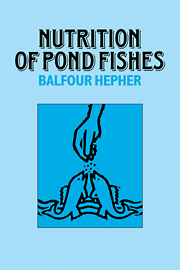Book contents
- Frontmatter
- Contents
- List of symbols
- Preface
- Introduction
- Part I FOOD REQUIREMENT
- 1 The balance of energy
- 2 Ingestion, digestion and absorption of food
- 3 Energy pathways
- 4 Maintenance
- 5 Growth
- 6 Requirement for protein
- 7 Other essential nutrients
- Part II FOOD SOURCES AND THEIR UTILIZATION
- Appendixes
- References
- Systematic index
- Subject index
6 - Requirement for protein
Published online by Cambridge University Press: 06 August 2010
- Frontmatter
- Contents
- List of symbols
- Preface
- Introduction
- Part I FOOD REQUIREMENT
- 1 The balance of energy
- 2 Ingestion, digestion and absorption of food
- 3 Energy pathways
- 4 Maintenance
- 5 Growth
- 6 Requirement for protein
- 7 Other essential nutrients
- Part II FOOD SOURCES AND THEIR UTILIZATION
- Appendixes
- References
- Systematic index
- Subject index
Summary
Protein is the basic component of animal tissues and is, therefore, an essential nutrient for both maintenance and growth. At maintenance level the fish requires protein for replacement of worn-out tissues and proteinaceous products such as intestinal epithelial cells, enzymes and hormones, which are vital for the proper function of the body, and are recycled quite rapidly. The requirement of protein for the synthesis of new tissues is obvious, since protein constitutes 45–75% of the tissue dry matter. The capacity of the fish to synthesize protein de novo from carbon skeletons is limited, and most of the protein must, therefore, be supplied through the diet. Thus, the content of protein in the diet and its ratio to the metabolizable energy becomes of prime importance.
Protein for maintenance
As with energy, the amount of protein required for maintenance can be measured by feeding fish a diet containing just enough protein to balance the loss due to the recycling of tissues, enyzmes, etc., so that the protein content of the body will remain unchanged (zero nitrogen balance). However, adjustment of this amount is rather difficult. Since loss of endogenous nitrogen in faeces and metabolic excretion continues whether the fish consumes protein or not, very often protein requirement for maintenance is determined by measuring this nitrogen loss on fish fed a protein-free diet. The rate of protein (nitrogen) loss can be measured either by determining the content of body nitrogen on successive samples, or by determining the content of nitrogen in the excretions.
- Type
- Chapter
- Information
- Nutrition of Pond Fishes , pp. 175 - 216Publisher: Cambridge University PressPrint publication year: 1988
- 1
- Cited by



